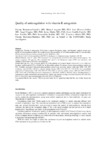Mostrar o rexistro simple do ítem
Quality of anticoagulation with vitamin K antagonists
| dc.contributor.author | Bertomeu-González, Vicente | |
| dc.contributor.author | Anguita, Manuel | |
| dc.contributor.author | Moreno-Arribas, José | |
| dc.contributor.author | Cequier, Ángel | |
| dc.contributor.author | Muñiz, Javier | |
| dc.contributor.author | Castillo-Castillo, Jesús | |
| dc.contributor.author | Sanchis, Juan | |
| dc.contributor.author | Roldán, Inmaculada | |
| dc.contributor.author | Marín, Francisco | |
| dc.contributor.author | Bertomeu-Martínez, Vicente | |
| dc.date.accessioned | 2015-08-24T11:06:25Z | |
| dc.date.issued | 2015-05-11 | |
| dc.identifier.citation | Bertomeu-González V, Anguita M, Moreno-Arribas J. Quality of anticoagulation with vitamin K antagonists. Clin Cardiol. 2015;38(6):357-364 | es_ES |
| dc.identifier.uri | http://hdl.handle.net/2183/14875 | |
| dc.description.abstract | [Abstract] Background. Vitamin K antagonists (VKA) have a narrow therapeutic range, and literature analysis reveals poor quality of anticoagulation control. We sought to assess the prevalence of poor anticoagulant control in patients under VKA treatment in the prevention of stroke for atrial fibrillation (AF). Hypothesis.Control of anticoagulation with VKA is inadequate in a high percentage of patients with AF. Methods.Patients with AF under VKA treatment were prospectively recruited in this observational registry. The sample comprised 948 patients. The estimated time spent in the therapeutic range (TTR) was calculated, and variables related with a TTR >65% were analyzed. Results.Mean age was 73.8 ± 9.4 years, and 42.5% of the patients were women. Mean TTR was 63.77% ± 23.80% for the direct method and 60.27% ± 24.48% for the Rosendaal method. Prevalence of poor anticoagulation control was 54%. Variables associated with good anticoagulation control were university studies (odds ratio [OR]: 1.99, 95% confidence interval [CI]: 1.08-3.64), chronic hepatic disease (OR: 8.15, 95% CI: 1.57-42.24), low comorbidity expressed as Charlson index (OR: 0.87, 95% CI: 0.76-0.99), no previous cardiac disease (OR: 0.64, 95% CI: 0.41-0.98), lower risk of bleeding assessed as hypertension, abnormal renal/liver function, stroke, bleeding history or predisposition, labile international normalized ratio, elderly age, and use of drugs or alcohol (HAS-BLED; OR: 0.81, 95% CI: 0.69-0.95), and lower heart rate (OR: 0.99, 95% CI: 0.98-0.99). Conclusions.Patients who receive VKA to prevent stroke for AF spend less than half the time within therapeutic range. | es_ES |
| dc.description.sponsorship | Instituto de Salud Carlos III; RD12/0042/0068 | es_ES |
| dc.description.sponsorship | Instituto de Salud Carlos III; RD12/0042/0010 | |
| dc.description.sponsorship | Instituto de Salud Carlos III; RD12/0042/0069 | |
| dc.description.sponsorship | Instituto de Salud Carlos III; RD12/0042/0049 | |
| dc.description.sponsorship | Instituto de Salud Carlos III; RD12/0042/0063 | |
| dc.language.iso | eng | es_ES |
| dc.publisher | Wiley | es_ES |
| dc.relation.uri | http://dx.doi.org/10.1002/clc.22397 | es_ES |
| dc.rights | This is the peer reviewed version of article which has been published in final form at Wiley Online Library. This article may be used for non-commercial purposes in accordance with Wiley Terms and Conditions for self-archiving. | es_ES |
| dc.title | Quality of anticoagulation with vitamin K antagonists | es_ES |
| dc.type | info:eu-repo/semantics/article | es_ES |
| dc.rights.access | info:eu-repo/semantics/openAccess | es_ES |
| dc.date.embargoEndDate | 2016-05-11 | es_ES |
| dc.date.embargoLift | 2016-05-11 |
Ficheiros no ítem
Este ítem aparece na(s) seguinte(s) colección(s)
-
INIBIC-ECAPE - Artigos [31]
-
GI- GRINCAR - Artigos [225]






